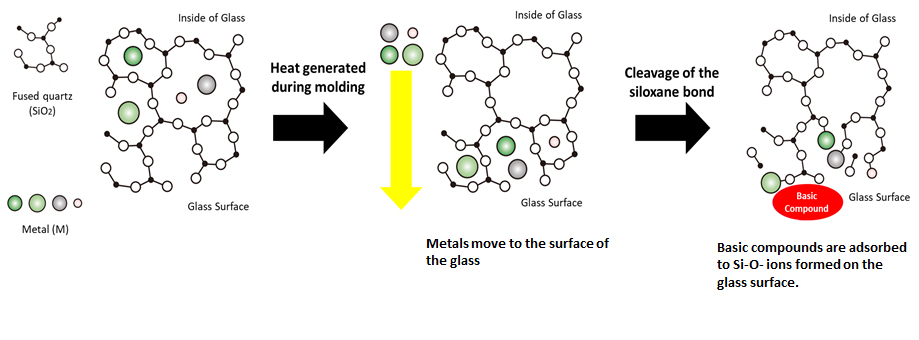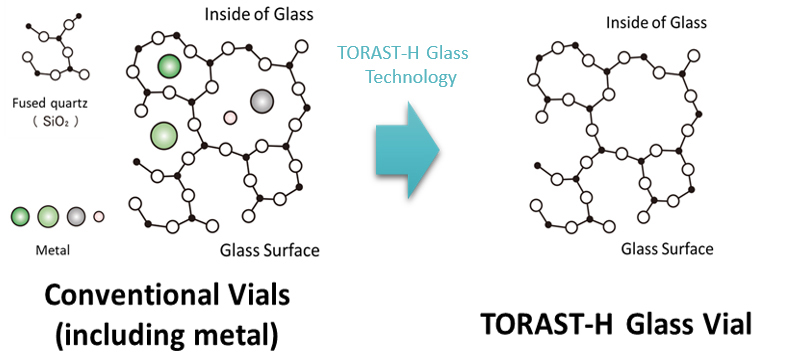Shimadzu has released the Nexera MX.
Nexera MX processes twice the number of samples as conventional LCMS systems in the same amount of time.
Low Adsorption Vial
LC/MS(/MS) has been introduced in many fields as an indispensable separation analysis method thanks to its high sensitivity and selectivity. Samples can therefore be detected even at low concentrations. However, the loss due to adsorption of the sample to equipment can adversely affect results.
Advances in instrumentation have been significant in reducing this sample loss, but consumables can become a limiting factor in achieving maximum performance.
That’s why, more than ever, consumables must be adapted to optimize results. Low adsorption is a key focus for improvement, and the TORAST-H series continues to move with the times.
The composition of the raw material used in the manufacture of vials varies depending on the type of glass, but in general 70-75% is SiO2, and the rest consists of metal (M) oxides. Metal oxides are added, for example, to improve the moldability of the glass by lowering its melting point. Metals tend to migrate to the glass surface during molding, so the surface of glass vials tends to have a high metal content.
These metal components break neighboring Si-O-Si (siloxane) bonds to form Si-O-M (metal silanolate) bonds. Compared to Si-O-H (silanol), Si-O-M is more easily ionized to form Si-O-, leading to ionic adsorption of base compounds

As in HPLC columns, metals included in silica gel increase the acidity of silanol, increasing the adsorption rate of basic compounds. This effect can be lessened by processing during the molding stage to remove metals from the surface only, but since the glass is in a fluid state, more metal components continue to move towards the surface. This type of processing has also been shown to reduce surface area uniformity.
Taking this into account, TORAST-H Glass Vials are formed through the application of a special treatment to the glass (TORAST-HT Glass Technology) to remove metal components from the glass. The treatment transforms the surface of the glass into silica glass, preventing ionic adsorption of samples.
The world-class low adsorption of TORAST-H Glass Vials is ensured not only through the incorporation of this treatment, but also the minimization of irregularities in the glass surface through careful control of the molding temperature, as well as medical-grade packaging that prevents organic layers from forming by hydrophobic adsorption.

Download the latest brochure.
Shimadzu has released the Nexera MX.
Nexera MX processes twice the number of samples as conventional LCMS systems in the same amount of time.
“Advanced i-Series” High Performance Liquid Chromatograph
Retaining the excellent basic functions of the flagship “i-Series”, the Advanced i-Series boasts increased pressure resistance and additional functions to support remote work including working from home.
Shimadzu has released the ELSD-LT III Evaporative Light Scattering Detector for HPLC.
The evaporative light scattering detector (ELSD) is a general-purpose universal detector that can even detect components with no UV absorption, such as carbohydrates, lipids, surfactants, and synthetic polymers.
Shimadzu has released the Microsampling Device, MSW2™ Type Udck™
For Research Use Only. Not for use in diagnostic procedures.
Shimadzu has released Shim-pack MC PLONAS Series.
Shim-pack MC PLONAS 2.7 μm columns reduce the back pressure yet maintain the performance of a sub 2 μm fully porous particle column. The pressure limit is 40 MPa.
Application Note: "Analysis of Pharmaceuticals' Impurity - Regulations and Analysis for Carcinogenic Substances -"